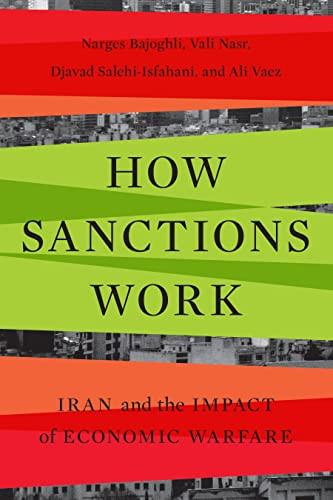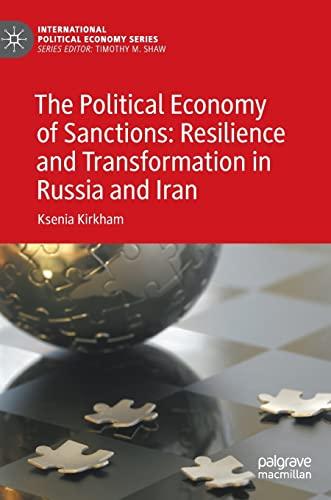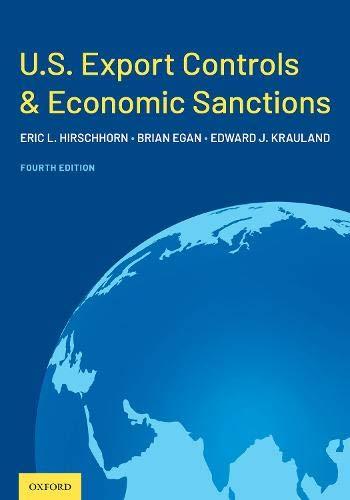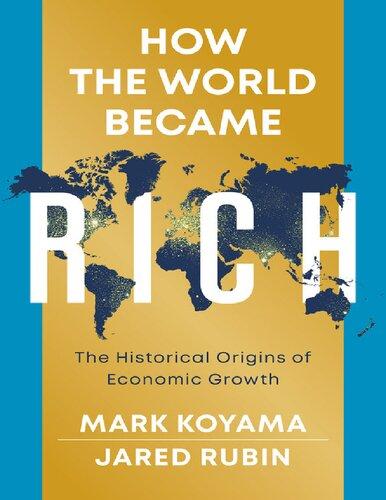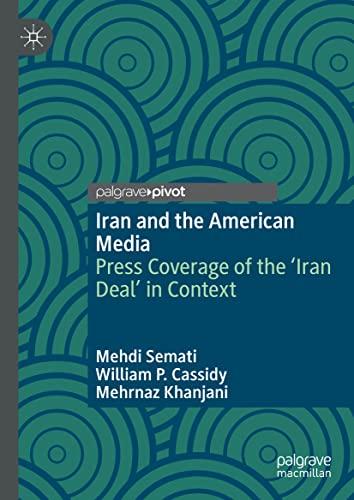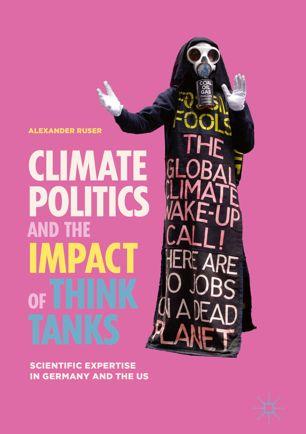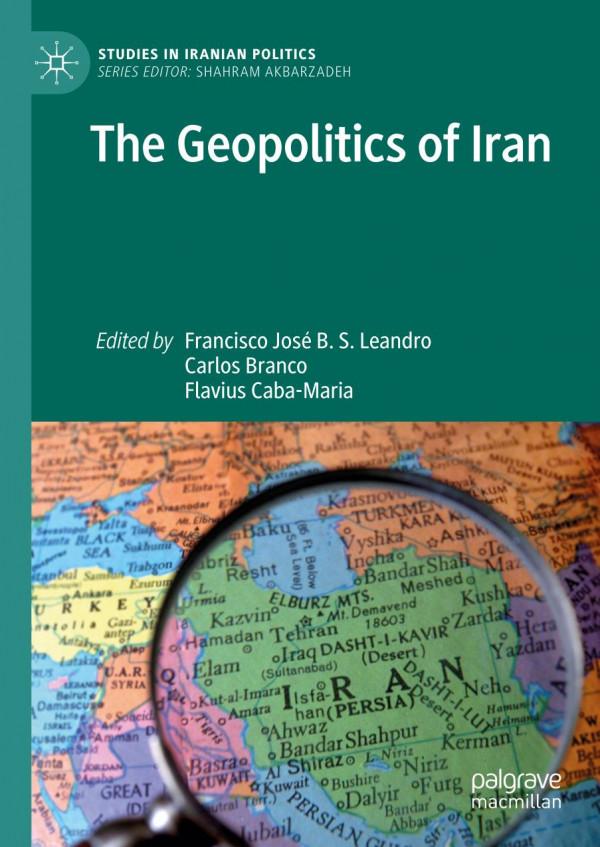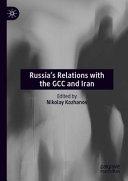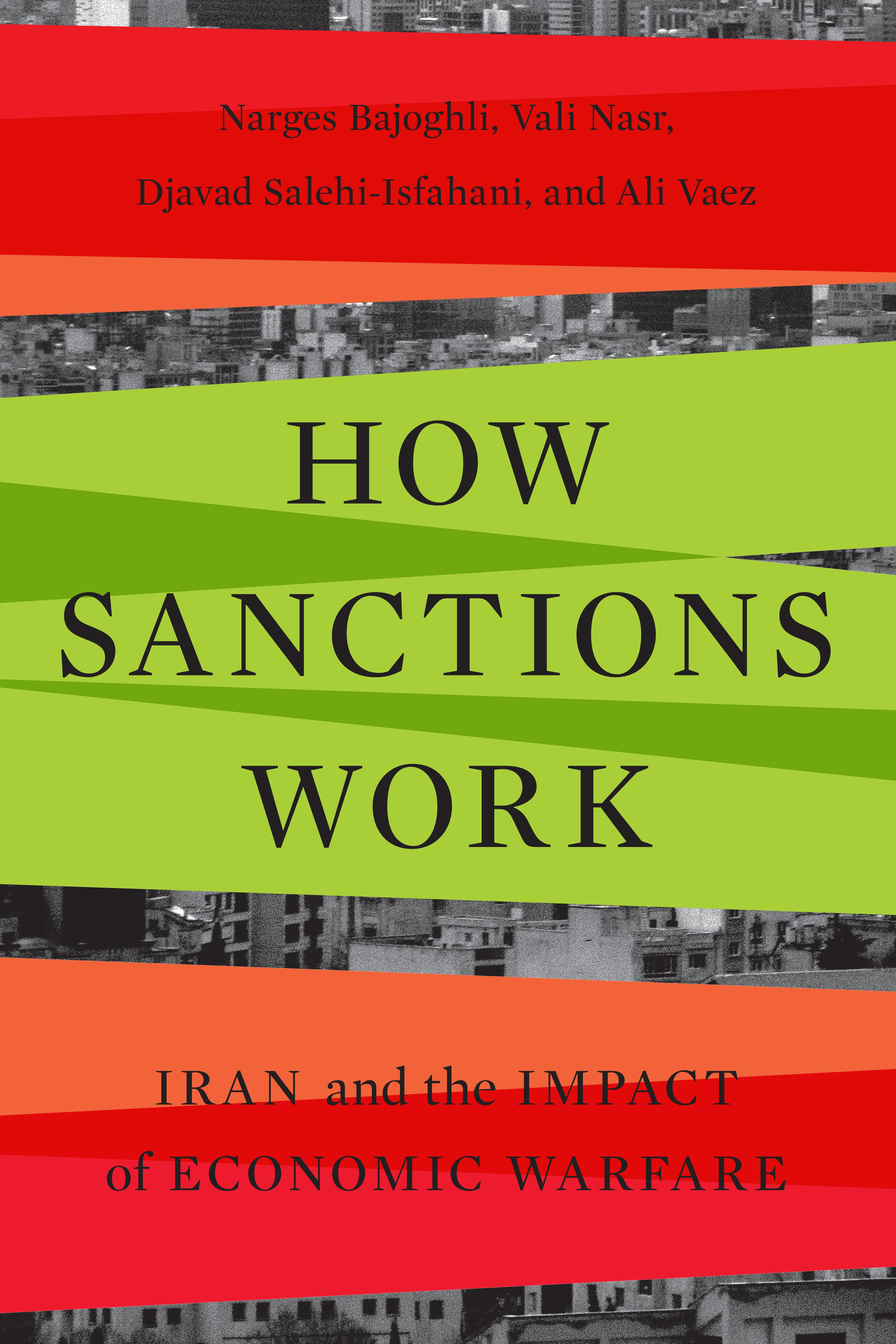SANCTIONS WORK
One of the most important developments in international affairs is the growing primacy of economic sanctions as a tool of foreign policy. Increasingly, the US response to international crises is first and foremost the application of sanctions. But do sanctions work? If so, when and how, and at what cost? The case of US sanctions on Iran is particularly instructive in this regard. For over four decades Iran has been a foreign policy concern for the United States: a country that refuses to deal directly with the US, and that maintains anti-Americanism at the core of its foreign policy and even its identity. The United States has addressed its Iran problem primarily through sanctions. Since their first imposition in 1979, sanctions have become more far- reaching and sophisticated; so much so that, at the time of this writing, Iran is the most sanctioned country in the world. In the process, the US has come to consider sanctions as a nearly unassailable necessity; to the point, we will argue, of a counterproductive overreliance on them.
Additional sanctions, and more punishing sanctions, have failed to realize US policy objectives. The experience of Iran shows how ineffective this seemingly effective foreign policy tool can be. Waged by warriors in dark suits in the US Department of the Treasury, the sanctions are assumed to be more efficient and less costly alternatives to what warriors in the Pentagon and diplomats at the State Department are capable of. The decades of sanctions exacted on Iran, and the application of
“maximum pressure” sanctions under the Trump and Biden administrations, challenge this assumption. The extended period also allows us to gain a better understanding of the humanitarian, social, and political costs of sanctions, as well as the less noticed costs that sanctions inflict on the US. The case of Iran also shows that sanctions are far from being an efficient tool; while they are more easily applied than direct military or diplomatic measures, that very facility is also at the root of their failure because they become so difficult to lift, regardless of whether they are accomplishing their goals.
The forty- plus years of US and international sanctions, and recently the maximal use of sanctions, have been levied on Iran not only to punish its behavior but also to force the Islamic Republic to change course: desist from supporting terrorist activities, refrain from aggressive regional policies, and abandon its nuclear ambitions. President Trump in particular believed in the promise of sanctions to achieve this course change, but his administration failed on each of these three counts, and in fact the threat of Iran has appeared to become increasingly grave on every front of concern to the US.
Iran has shown greater defiance and more willingness to directly and dangerously confront the US and its allies in the Middle East. The application of maximal sanctions, beginning in 2018, provoked an aggressive response from Tehran. A year after the imposition of maximum pressure, Iran attacked four tankers off the coast of the United Arab Emirates (UAE) port of Fujairah on the Gulf of Oman; downed a high- flying US surveillance drone; and launched a sophisticated attack with drones and missiles on oil facilities in Abqaiq and Khurais in eastern Saudi Arabia. The audacity of this latter attack, and Iran’s ability to evade Saudi and American radar and air defense systems, caught Washington by surprise. But all of the aggressive actions were cause for alarm, given that Iran carried them out while subject to the worst sanctions it had ever faced. In 2022, the world was shocked when Russia deployed lethal drones that Iran had developed under sanctions.
Throughout 2019–20, the US response to Iranian provocations only invited escalation. After US missiles attacked an Iraqi militia base in response to the killing of an American contractor, Iran and its Iraqi allies laid siege to the US Embassy in Baghdad. In turn, the United States used
an attack drone to kill Iranian general Qasem Soleimani, who played a key role in Iran’s regional policies. Iran was neither chastened nor deterred, and in January 2020 it launched nearly two dozen Iranian- built ballistic missiles at a military base in Iraq, which hosted US forces. This attack on the Ain al-Asad base in Iraq— in retaliation for the assassination of Soleimani—was not only a precise strike, but the largest missile attack US troops have ever faced.
Through such actions, Iran showed that Trump’s maximum pressure sanctions had not bent the nation’s will to accept Western demands. Instead, the sanctions had achieved the opposite effect: making Iran more aggressive, risk- taking, and dangerous. Indeed, this was a consequence of sanctions. Instead of sanctions offering an “alternative to war,” maximum pressure sanctions on Iran have shown that they could be a cause of war.1
“Do sanctions work?” is often asked by policymakers and pundits. Perhaps that is the wrong question. When a country with the size and economic power of the United States imposes harsh sanctions on a country, of course they “work”: sanctions create massive disruptions in the everyday lives of citizens, impact the political culture of the targeted state, and induce shocks in the economy. But do sanctions— as some claim— bring about the behavioral changes in targeted states as intended by Western foreign policy? Do sanctions work the way they “should”?
Consider Iran, the most sanctioned country in the world. Comprehensive sanctions are meant to induce uprisings or instigate pressure that leads to a change in the behavior of the ruling establishment, or a lessening of its hold on power. But after four decades, Iran has shown the opposite to be true. In fact, despite periodic protests, sanctions have strengthened the Islamic Republic, weakened and impoverished its population, and increased Iran’s military posture vis- á-vis the US and its allies in the region. It is not only that the Islamic Republic is still around despite harsh sanctions; most importantly, Iran has become a more belligerent state as a result of increased American sanctions.
As this book shows, then, sanctions do work. But not in the way most think.
This page intentionally left blank
ACKNOWLEDGMENTS
To our many interlocutors inside Iran who opened up their lives and worlds to us over the years in hours of interviews and conversations, our heartfelt gratitude. We hope that we have done justice in these pages to your life stories.
We would like to thank the scholars who have participated in the Iran Under Sanctions project at Johns Hopkins University, and whose invaluable insights contributed greatly to this book: Esfandyar Batmanghelidj, Orkideh Behrouzan, Shahrokh Fardoust, Kevan Harris, Kaveh Madani, Adnan Mazaeri, Arzoo Osanloo, Hadi Salehi Esfahani, Tara Sepehri Far, Nazanin Shahrokni, Alexander Soderholm, Leili Sreberny- Mohammadi, and Sara Vakhshouri.
Thank you to Ghadir Asadi, Brendan Keating, and Arin Shahbazian for their research assistance.
We are extremely grateful to Ben Platt not only for his expert editing skills but also for his many conversations and prompts that helped expand this manuscript in fruitful ways. Thank you for believing in the importance of this project and for being an incredible intellectual interlocutor along the way.
Thank you to Kate Wahl at Stanford University Press for her support of the book and to our editor at Stanford, Daniel LoPreto, for his enthusiasm for our work and helping to so expertly bring it into the world. Many thanks to Marie- Catherine Pavel and the rest of the team at SUP for all their hard work. A special thanks to the anonymous reviewers, whose recommendations strengthened the book.
This page intentionally left blank
INTRODUCTION
The Invisible War
“I am a forty- four-year- old woman who has lived forty- one years of her life under varying degrees of economic sanctions,” said Habibe Jafarian, a writer and editor, writing nearly two years into the US “maximum pressure” sanctions on Iran. “I grew up with the sanctions; I went to school with them; I learned to read and write with them hovering over my head; I fell in love, and began my career as a journalist, and have stayed alive, all under sanctions from the United States of America. Sanctions have been a part of my life like the weather.”1
A century before Jafarian’s lament, US president Woodrow Wilson described sanctions differently. Sanctions, he explained in 1919, are “an absolute isolation . . . that brings a nation to its senses just as suffocation removes from the individual all inclinations to fight . . . Apply this economic, peaceful, silent, deadly remedy and there will be no need for force. It is a terrible remedy. It does not cost a life outside of the nation boycotted, but it brings a pressure upon that nation which, in my judgement, no modern nation could resist.”2
Yet the Islamic Republic has demonstrated that a nation can, in fact, resist attempted economic suffocation. The pressures of sanctions have not reduced tensions in the region nor have they turned Iran into a ruined shell of a nation ready to abide by Western dictates. The pressures of maximal sanctions have contributed to vast social uprisings, but each
time the state has responded with violent repression and the further suppression and securitization of civic spaces.
That sanctions have failed to match their intended goal is damning enough. But, as Jafarian makes clear, even worse is that sanctions don’t decisively end conflicts. Instead, sanctions can linger on for decades, antagonizing the state even as they impoverish and harm ordinary people. Most of all, sanctions, once started, are seemingly impossible to stop. After all, how does one stop the weather?
Revealing the truth about sanctions is the goal of How Sanctions Work. How, for example, do prolonged comprehensive sanctions affect a targeted country’s society, politics, and economy? Are they, in fact, a costless tool for the United States and the Western- led international system— something that can be done easily “over there” with no impact “over here”? What does it mean for a country to experience four decades of economic sanctions? And what are the ricochet effects of sanctions in international politics, if any?
Iran is the perfect case study for understanding sanctions broadly. It is also a worthy site of examination in its own right. Despite the fact that Iran has been under decades of Western sanctions, little systematic knowledge exists on the short-, medium-, and long- term impacts of sanctions on the growth patterns of the Iranian economy, or on the general welfare of its people in the cities and rural areas, or on societal dynamics, or on civic space, or on the country’s environment. Instead, the focus has often been on a few metrics that flare up with the tightening of sanctions: currency depreciation, inflation, and recession, which are then followed by increases in unemployment and poverty. Yet the more comprehensive picture remains lost in political cacophony.
We aim to correct that lacuna. In this book, we analyze what prolonged comprehensive sanctions have done to Iran’s society, politics, and economy; moreover, we show what these decades of sanctions have cost Iran, the United States, and the broader international economic and political order.
We take readers inside Iran, to hear from Iranians from different walks of life and from across the political spectrum about their experiences living under decades of economic sanctions. We examine the be -
havior of state and military actors, as well as opposition activists inside the country. We take a critical look at the economic data to understand how the Iranian state has attempted to resist sanctions and what their impacts have been on the lives of citizens. As we analyze the impacts of comprehensive sanctions on Iran’s society, economy, and domestic and regional politics, we also consider the blowback costs of sanctions to the international community— a point, we argue, that needs to be considered more seriously as Washington levies additional sanctions on larger states, such as Russia.
Ultimately, our aim is to show how sanctions have impacted the political calculus of those in power in Iran: who sanctions have empowered and who they have disempowered. What we found inside Iran is alarming. As the use of this “economic weapon” has proliferated against Iran, the Iranian state, in response, has become more militaristic. Prolonged, comprehensive sanctions on Iran have created shocks within society: leading to new social classes, changing social bonds, and a hardening of the political sphere. These trends have only accelerated since the imposition of maximum pressure sanctions in 2018.
Why would Iran react in these specific ways? Because the Trump administration’s maximum pressure campaign—which the Biden administration has continued unabated— is in effect a “shadow war,” fought on multiple fronts and across the region, against Iran and its allied forces. Shadow wars are intelligence wars first and foremost. And so, in response, Iran has relied on the Revolutionary Guard’s extraterritorial forces, the Quds Force, and the intelligence services of the Revolutionary Guard. Indeed, Iran has infused this shadow war worldview into all realms of decision- making within the Islamic Republic. Sanctions have caused the Iranian government to increasingly view the world as waging external and internal war on Iran, outside in the international community and inside its own borders.
Such a sanctions- derived worldview has had an outsized impact on Iranian political culture, anchoring it in security and repression. Iran has responded to sanctions by intensifying the “securitization” of the domestic sphere: meaning that civil liberties are even more repressed, and importantly, activists have been lethally targeted, imprisoned in larger numbers, or have withdrawn from their activities. Although Iran, due to the size and makeup of its economy, has not faced the humanitarian
crises that have resulted from comprehensive sanctions in Cuba, Venezuela, and Iraq in the 1990s, its medical, educational, and agricultural sectors are showing cracks under the economic pressure.
Ultimately, sanctions have enriched— by orders of magnitude— enterprises tied to the Revolutionary Guard and the supreme leader’s office. While it is nearly impossible to provide exact numbers, given how sanctions- busting requires trade on the black and gray markets, with attendant bribes and kickbacks, it is crucial to acknowledge that sanctions have lowered economic transparency, weakened the independent private sector, and strengthened business owners with ties to the regime, and especially the Revolutionary Guard. All of which has led to major shifts in who comprises the capitalist class in society, with long- term consequences. As later chapters show, Iran’s middle class— the sector of society from which much of the resistance against the Islamic Republic has stemmed, and the sector that therefore should be supported by Western policy— has been impoverished in tandem with the escalation of sanctions pressure, and markedly since 2018. These trends are not promoting a more peaceful Iran, but, instead— both internally and externally— a more violent one.
Bombs may not be dropped under long- term comprehensive sanctions. Even so, such sanctions create social realities and generational impacts akin to war.
This understanding— of sanctions as war— contradicts commonly held views on sanctions. Throughout most of their history, economic sanctions have been imposed without much regard for their impacts: the humanitarian costs have been dismissed as necessary, and the political costs as marginal.3 By and large, policymakers and scholars in the West presume that sanctions (eventually) work; that if the tools of sanctions are tweaked just right, the targeted actors suffer and eventually change their bad behavior.
Why did this belief take hold? In the aftermath of the horrors of World War I, Western leaders and policymakers sought to create peaceful tools as an alternative to war. The idea of economic sanctions was born.4 Their appeal was in what they portended: the application of pressure on a “bad actor” to induce change, not by military exertion and dead soldiers, but by policymakers, lawyers, and bankers sitting behind desks. The
notion that economic sanctions could leverage a certain kind of power that would help avoid conflicts and diminish the need for troops has appealed to many in the West since the early twentieth century. Now, with Americans becoming warier of troop deployments, economic sanctions come across as a desirable alternative: reinforcing the belief that “we are doing something,” but without the costs associated with armed conflict. Today, economic sanctions are among the most salient tools in US foreign policy, “one of liberal internationalism’s most enduring innovations of the twentieth century.”5
Yet the research and literature on the impacts of sanctions, especially over time, remains unfortunately thin.6 Sanctions have become a favored foreign policy tool in Washington and the European Union, but they have held that favored position even though their impacts remain largely understudied, and therefore mostly unknown. Worst of all, despite their unknown impact, US sanctions have increased by more than 900 percent since the start of the twenty- first century.7 It is this increase of an unexamined tool that makes it especially vital to reveal how sanctions really work.
For revealing the truth about sanctions, Iran is the perfect case study. Moreover, given that Iran is the most sanctioned nation in the world, it is worthwhile to illuminate the unique struggle of Iran and its people.
In the early 1950s, Iran experienced Western economic blockades and sanctions for the first time in response to its prime minister, Mohammad Mosaddegh, nationalizing his country’s resources, the first third world leader to do so. When Mosaddegh’s government ended the unjust agreement that gave the Anglo- Iranian Oil Company complete control of the country’s oil, Great Britain not only imposed sanctions on Iran but also supported the coup in 1953 that removed Mosaddegh. Great Britain’s aim was twofold: to protect its oil interests in Iran and to make an example of Mosaddegh in order to deter other newly independent countries from nationalizing their own assets. While the purpose of those sanctions was to force Iran to yield to British demands, it is important to note that a military coup, not sanctions, ended the crisis in the 1950s. Nor did sanctions on Iran dissuade Egyptian president Gamal Abd al- Nasser from nationalizing the Suez Canal shortly after in 1956. The sanctions on Iran in the 1950s were lifted once there was a
new government in place willing to arrive at a new oil agreement with Western oil companies.
The belief that Iran had experienced a serious blow to its sovereignty when Mosaddegh was removed from power in 1953 festered internally over the following decades, eventually manifesting as a main driver of the 1979 Iranian Revolution, and has fueled resentment toward the West ever since. The coup and revolution set Iran on a collision course with the West, and sanctions were its first manifestation.
Sanctions returned in 1979. Since then, Iran has been repeatedly sanctioned over the ensuing decades for a variety of reasons. In fact— even though in this book we focus mainly on the experience of Iranians under the nuclear sanctions— the sentiment exists in Iran that the country will never free itself from sanctions, as long as it refuses to abide by US hegemony in the Middle East.
“If the nuclear sanctions get removed,” explains an Iranian university professor interviewed for this book, “then the West will sanction us for our ballistic missiles. Then it’ll be human rights sanctions. Then it’ll be another reason for sanctions. Just look at any country that has challenged Western power—whether political or economic—what do you see? They get sanctioned in order to break their will and make them succumb to Western power.”
In a sense, this professor is right. Sanctions originated in the aftermath of World War I. Western sanctions were soon used on states that defied Western norms: the Soviet republics of Russia and Hungry in 1919. Blockades of these states were enacted because, from the beginning, sanctions “were considered suitable for use mainly against peripheral European states and ‘semi- civilized’ countries.”8
“Just look at any country that has challenged Western power.” In the case of Iran, then, the history of sanctions—who is sanctioned, and what that means about the underlying principles of the international community— cannot be overlooked, neither by Iranians nor by those studying how sanctions really work.
Some might argue that, despite this troubled history, sanctions have worked in Iran. After all, wasn’t it sanctions that compelled Iran to agree to negotiations in 2013 and then sign on to the 2015 “nuclear deal”?
Iran did show more flexibility in 2013, after President Obama in -
creased sanctions. Thus, many in Washington touted this as proof that the Obama- era comprehensive sanctions against Iran worked, setting the stage for the 2015 nuclear deal (technically, the Joint Comprehensive Plan of Action or JCPOA). Trump tore up that deal in 2018 and increased sanctions on Iran from 750 to over 1,500, with the stated logic that he could get a “better deal” with more pressure.
But, as we see in later chapters, Trump’s action failed; 2018 would not be 2013. Simply applying more sanctions, it seems, does not achieve policy goals. Why?
As this book will show, there is a flaw in the logic of sanctions. As painful as the experience of sanctions has been, it has also forced Iran’s leaders to create infrastructure to resist sanctions. In fact, Iran’s current supreme leader, Ayatollah Ali Khamenei, has called for the creation of a “resistance economy” (discussed in chapters 2 and 4) and has tasked policymakers to search for ways to increase the resilience of Iran’s economy in the face of sanctions in order to build long- term economic stability. Indeed, such an outcome was the goal of many Iranian leaders, regardless of what political regime they served.9 It is plausible to argue that, as bad as sanctions have been for Iran’s economy, these external restraints have forced the country to rely more on its non- oil resources for economic growth.
Sanctions, then, have not forced Iran to stagnate. Instead, sanctions have actually forced Iran to innovate; just not in ways that are amenable to the West. The result is that Iran has evolved along a path that has been dictated by sanctions. Its economic and social institutions, politics, and more broadly the nature of its state, reflect that path dependency, one which we know from the history of states around the world is not easily corrected and likely irreversible.
Sanctions offer incentives for certain kinds of development, and present obstacles to others. After four decades, it is clear that those incentives have not pushed Iran toward a more just society and a more peaceful role in the world. Instead, sanctions have created an economy both resilient and resistant, one capable of— and ready to— shower missiles on US military bases or Ukraine’s civilian infrastructure. And, within Iran’s borders, sanctions have impoverished nearly all elements of society except, perhaps, the Revolutionary Guard and the businesses and social strata
allied with them, the very institutions and classes that sanctions have targeted.
When economic sanctions were first envisioned after World War I, it was assumed that they would not be used.10 The devastating impact of sanctions would be worse than war, which would deter countries from engaging in adventurous foreign policy behavior that would disturb the international order. Russia’s invasion of Ukraine, begun during the US’s maximal sanctions assault on Iran, shows that the deterrence value of sanctions is not what it is made out to be.
If more countries risk sanctions to challenge the international order, then sanctions will become purely punitive. They will no longer deter. Instead, they will simply shrink global economic relations, which would, in turn, make defying sanctions easier.
Despite their intention, sanctions are not diplomacy nor are they instruments of peace. As the case of Iran shows, sanctions wage war on societies within their own borders, and at the same time loosen war on the wider world.
Methods
As anthropologists, political scientists, economists, and policymakers, we engaged a variety of research methods for this book. We did so with the aim of providing a fuller picture of how prolonged comprehensive sanctions both impact the targeted society and reverberate outward into international politics and economics.
We first began to untangle the multifaceted impacts of sanctions in 2019 at Johns Hopkins University, gathering dozens of leading scholars from international institutions: a multidisciplinary group that included economists, climate and energy scientists, and social scientists to explore the multifaceted impacts of sanctions on Iran. The scholars all conducted original research and were able to place their observations within the wider context of their long- term engagement with and scholarship on Iran.11 We continue to engage different researchers to produce new scholarship on the impacts of sanctions in order to better, and more deeply, understand how sanctions work on a targeted society.
In addition to that body of work, this book also draws on multiyear, long- form oral history interviews with eighty Iranians inside Iran, including political and social activists; political actors; university profes -
sors and researchers, especially those conducting their own research on the impacts of sanctions on Iranian society; psychiatrists and social workers; workers (white collar and blue collar); large independent business owners; and former members of the Revolutionary Guard who are now business owners. Furthermore, multiyear discourse analysis of Persian- language media and social media was conducted.
The economic analysis in this book relies primarily on survey data and official global and Iranian statistics. Iran produces more survey data than most developing countries— about fifty surveys of income and expenditures and labor force surveys are publicly available in unit record. These surveys have been used and tested by researchers across the globe, and are generally considered reliable and of high quality. In addition, they are consistent with 2 percent samples of census data that are also available. Other official economic data (GDP, inflation, etc.) are also publicly available and are generally accepted by international institutions.
The analysis of all these aspects of sanctions is broken into thirds. Chapters 1 and 2 examine the impact of sanctions on the internal society and politics of Iran. Chapters 3 and 4 explore the economic history of sanctions alongside their escalation over the decades. Chapters 5 and 6 reveal the true costs of sanctions, not just for Iran but for the world at large. The Conclusion raises moral concerns about economic sanctions that predominantly target noncombatant civilians, and shows that the efficacy of sanctions as a foreign policy tool is open to question.
When Society Is Sanctioned
Fariba— a recently retired teacher, who once led a solidly middle- class life in Tehran with her husband, an electrical engineer— struggles to get by today.1 “Every day I leave the house, the prices at the fruit sellers go higher and higher. We’ve reduced what we buy quite heavily.” Her daughter and son live abroad. “When my daughter suggested that she send money to us on a monthly basis to help out, I died inside. As parents we’re the ones who are supposed to ensure the stability of our children, not the other way around, not when both my husband and I are still relatively young and have worked our whole lives.”
Fariba keeps herself busy by joining her former colleagues in organizing teachers’ protests for higher pay. “I gather with them a few times a week to talk and strategize and join them on the streets in protests. At least we’re doing something. Being around others like me as we agitate for some changes gives me an avenue to take out my anger and frustrations about the hard times we’re living through.”
To make ends meet, Fariba sold a small plot of land that she had inherited from her father in their provincial town over two hundred kilometers outside of Tehran. “Before these sanctions, that money could have lasted us for many years. But now we’re budgeting our daily expenses in order for this money to stretch as far as possible. At least my children are already out of the country and I don’t have to think about
their future or how to provide a good life for them here,” she says with resignation in her voice.
In interview after interview, Iranians across the country recount how the rise in prices has been “utterly insane.” And this rise is the direct result of the increase of comprehensive US sanctions under President Trump; sanctions that, as of this writing, President Biden has continued unabated. From 2019 to 2022, Iranians explain in interviews just what happens to society when such extreme sanctions are imposed.
They recount how the increased prices force them to cut back on purchases or pawn their prized possessions. Or they express exasperation, uncertain of how to move forward. Middle- class families bemoan the loss of their life savings and are anxious about their futures and those of their children. Those in the working classes have found themselves in even more precarious situations, as they hustle to make rent, feed families, and survive. Families in rural areas have descended rapidly into poverty.
In comparison to other countries under comprehensive sanctions (such as Venezuela, Cuba, and Zimbabwe), Iran has an education and health system that has developed on par with middle- income countries.2 Moreover, the country is relatively food- sufficient. Thus, while the steep rise in food prices due to sanctions has shrunk food pantries and calorie intakes, there are no food shortages in Iran from sanctions.
Nonetheless, maximum pressure sanctions have plunged many Iranians, in both rural and urban areas, into poverty. It is true that the black and gray markets, which are endemic to sanctions- busting, have created enormous wealth for those at the top strata of society. Yet such markets, simultaneously, have greatly increased economic inequality. Over eight million individuals have fallen from the middle class to the lower middle class. And the ranks of the poor have swelled by more than four million.3
These shocks to Iran’s economy have forced changes in Iran’s society. In response, new social classes are emerging, social bonds are changing, and domestic politics has swung toward the hardliners. Meanwhile, attacks on civil and political liberties have become even more severe. Bombs may not be dropped under long- term comprehensive sanctions. Even so, such sanctions create social realities and generational impacts akin to war.
Sanctions target the economic lifelines of a society. In so doing, prolonged comprehensive sanctions induce an environment of siege,
shortage, and intense pressure, bearing down in the form of collective punishment. Richard Nephew, a key architect of US sanctions on Iran in the Bush and Obama administrations, writes:
Because of the different practical effects of sanctions and military force, policymakers treat these two tools differently. Military conflict creates causalities and damage for each side, and the results are visible for all to see. The impacts of sanctions can be less visible and may seem less destructive, certainly on a visceral level. This no doubt explains part of the attractiveness of sanctions as a tool of force. . . . But on a strategic level, the imposition of pain via sanctions is intended to register the same impulses in an adversary as those imposed via military force. . . . And just because the damage wrought by sanctions may be less visible (at least, with some sanctions regimes), it need not be less destructive, particularly for economically vulnerable populations that may be affected [emphasis added].4
If society is like a sea, then prolonged sanctions regimes create waves: leading to the rise of new social classes, new economies (especially in black and gray markets), new coping mechanisms, a heavy brain drain, the breakdown of infrastructure, and the further militarization of politics in impacted countries.
In this chapter we ask: What do economic siege and comprehensive sanctions “do” to a country’s society? What happens when members of the middle class confront the (often sudden) loss of value of their income and savings? Has Iran’s society changed in the way that those who sanctioned it intended? And what can all this tell us about sanctions in the abstract?
Since sanctions— especially prolonged comprehensive ones— impact multiple sectors and domains of life simultaneously, it is nearly impossible to isolate only the ways sanctions impact social life. Yet scholars in different countries have observed similar direct consequences, especially over time. Humanitarian catastrophes resulting from comprehensive sanctions— such as food shortages,5 the breakdown of medical systems,6 and the unavailability of critical medicines— have led to thousands of deaths around the world.7 The United Nations special rapporteur on unilateral coercive measures said, after a May 2022 visit to Iran,
that sanctions were especially affecting those suffering from “severe diseases, disabled people, Afghan refugees, women- led households and children.”8
Comprehensive sanctions regimes also target critical infrastructure and the opportunities available for knowledge producers, professionals, and students. Over time, this leads to compounded crises that span generations: distressed hospital systems, brain drain, and a decline in the quality of education. It can have a difficult- to- quantify but clearly destabilizing effect on social life: a pervasive hopelessness at the demoralizing prospect of vanishing dreams and aspirations.
Maximum pressure sanctions have indeed increased outward expressions of anger and frustration toward the ruling establishment in Iran and generated discourses of state failure. It may appear as if this evidence suggests that sanctions are working. Yet, as this book demonstrates, despite palpable and growing popular discontent, maximum pressure sanctions have actually weakened the Iranian population and made it more dependent on the state.9 Simultaneously, these sanctions have further securitized and militarized the domestic sphere. Hamid, a disaster management specialist in the civil society sector, responds angrily when I ask him about the sanctions. “Don’t ask me about the sanctions. Don’t write about the sanctions. All they’ve done is make the Revolutionary Guard more powerful. Those of us in civil society are suffocating—we’re constantly worried about saying something that may come across as a ‘security threat’ by those in charge.”
This chapter argues that comprehensive sanctions have produced four key social changes in Iran. First, comprehensive sanctions have created conditions of mass suffering. Second, comprehensive sanctions induce the world to view— and invent— Iranians as enemies. With no clear path to sanctions removal, all facets of Iranian society and the movement of Iranian peoples are regarded as either outright illegal or subject to constant legal scrutiny. This contributes to the creation of what we term an “everyday life of resignation.”
In this atmosphere of resignation, sanctions prompt the third and fourth key social changes: the growth of independent autarkic institutions and businesses, and the general exit from arenas of civic engagement with a corresponding retreat into private life. Such an inward turn is especially notable in the lives of activists and artists, in contrast to the
effervescence of civil society activity that was ubiquitously credited with the collapse of the Berlin Wall and democratization of Eastern Europe in the 1990s.
Ultimately, then, comprehensive sanctions impact the everyday lives of the vast majority of the population: impoverishing them, making them more reliant on the state for help, and driving exponential inequality. And in the face of this multipronged war, moreover, the state and its military apparatus become wealthier and more militaristic, both externally and internally, while society increasingly weakens.
Mass Suffering: Disaster Swarms and Discourses of State Failure
Iran now faces what Yarimar Bonilla (writing about Puerto Rico and its neighbors) conceptualizes as “disaster swarms.”10 Disaster swarms characterize places facing “economic crisis, imperial violence . . . earthquakes . . . climate change, privatization, profiteering, and other forms of structural and systemic violence all acting as a disordered jumble upon a collective body that cannot discern a main event or a discrete set of impacts, only repetitive and enduring trauma.”11 In the case of Iran, US maximum pressure sanctions (ongoing since 2018) have coincided with seemingly endless waves of COVID-19 (the pandemic has impacted Iran more than any other country in the Middle East), increased tensions between Iran and its regional adversaries, chronic state mismanagement, severe droughts, natural disasters, profiteering and increased privatization, political upheaval, and threats of chaos and even war. The resulting trauma and stress have entered into the everyday lives of Iranians, alarming Iranian psychiatrists, psychologists, and social workers.
Nazanin is a 63-year- old mother and wife who has run a small catering business from her home in Tehran for fifteen years. The main breadwinner of her family, she has worried about their future since the price of food sharply increased after the maximum pressure sanctions imposed by US president Trump in 2018. “On top of sanctions, when COVID-19 hit Iran in February 2020 and we eventually started lockdowns, I thought that’s it for me and my family. My whole business relies on people getting together for gatherings and on businesses having in- person functions.”
Nazanin had gotten her family through tough years before. Her husband was a technocrat at a state ministry. It was steady income, but it barely allowed them a middle- class life. When her two children were in
their teens, her husband began battling alcoholism. “We lost the small apartment we had and became renters. That’s when I decided to start my own business. I couldn’t allow my kids to face such an uncertain future as their father dealt with his addiction.” Nazanin’s business eventually flourished and allowed her family to reclaim a middle- class perch, albeit one without home ownership in Tehran’s hot real estate market. And so, when her business took a heavy hit with the onset of Trump- era sanctions and COVID, Nazanin’s family found themselves dealing with the heavy stress of insecure housing. “Making monthly rent is hard enough under normal circumstances when you run your own business and it all depends on how many clients you have per month. But add to that the looming feeling that my business might be gone for good because of skyhigh food prices and then the pandemic, and in the middle of all of that my daughter was getting a divorce . . . I was having nervous breakdowns. My daughter took me to see a therapist.”
Leeda, a psychiatrist and professor at a leading university in Tehran, has been overwhelmed with patients. “The combination of the sanctions making life harder for people and later the pandemic,” she explains, “has caused a mental health crisis in the country.” Along with her colleagues, Leeda organizes monthly meetings to discuss what they are hearing from their patients and how they can better support those who come to see them. Taboos around mental health have steadily decreased over the years; now, Iran boasts large communities of people tuned into new- age self- help books, group sessions, conversations around mental health on state television, and pop psychology Instagram pages. Such a turn has made talking about mental health and seeking therapy and counseling more of a norm, especially in large urban centers. For her part, Leeda has created both public and private seminars to engage more people and has started to toy with podcasting as another potential avenue to engage a wider community. “The sheer numbers of patients we’re seeing is incredible,” Leeda admits. And so, along with her colleagues in sociology and social work, Leeda helps to initiate research studies to trace longer- term impacts of the sanctions.
“Some of the most dire things we heard from people were in our interviews in late 2019 and early 2020,” explains Hamed, a leading sociologist involved in the research. “The shock of the sanctions had entered society and people were extremely worried. It was unclear what Trump would do next. There were huge nationwide protests in November 2019
